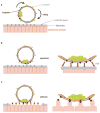An integrated view of L-selectin and trophinin function in human embryo implantation
- PMID: 18412772
- PMCID: PMC2726777
- DOI: 10.1111/j.1447-0756.2008.00776.x
An integrated view of L-selectin and trophinin function in human embryo implantation
Abstract
Determining molecular mechanisms of human embryo implantation is an extremely challenging task due to the limitation of materials and significant differences underlying this process among mammalian species. Recently, L-selectin and its ligand carbohydrate have been proposed as a system that mediates initial adhesion of human blastocysts to the uterine epithelia. We have also identified trophinin as a unique apical cell adhesion molecule potentially involved in the initial adhesion of trophectoderm of the human blastocyst to endometrial surface epithelia. In the mouse, the binding between ErbB4 on the blastocyst and heparin-binding epidermal growth factor-like growth factor on the endometrial surface enables the initial step of the blastocyst implantation. The evidence suggests that L-selectin and trophinin are included in human embryo implantation. This review summarizes findings relevant to the functions of L-selectin and trophinin in human embryo implantation, and proposes a model that reconciles these cell adhesion mechanisms.
Figures


Similar articles
-
Cell adhesion molecules in human embryo implantation.Sheng Li Xue Bao. 2012 Jun 25;64(3):247-58. Sheng Li Xue Bao. 2012. PMID: 22717627 Review.
-
Trophinin, tastin, and bystin: a complex mediating unique attachment between trophoblastic and endometrial epithelial cells at their respective apical cell membranes.Semin Reprod Endocrinol. 1999;17(3):229-34. doi: 10.1055/s-2007-1016230. Semin Reprod Endocrinol. 1999. PMID: 10797941 Review.
-
Recent molecular approaches to elucidate the mechanism of embryo implantation: trophinin, bystin, and tastin as molecules involved in the initial attachment of blastocysts to the uterus in humans.Semin Reprod Med. 2000;18(3):265-71. doi: 10.1055/s-2000-12564. Semin Reprod Med. 2000. PMID: 11299965 Review.
-
Signal transduction in human embryo implantation.Cell Cycle. 2007 May 15;6(10):1153-6. doi: 10.4161/cc.6.10.4266. Epub 2007 May 11. Cell Cycle. 2007. PMID: 17495530
-
Trophoblast cell activation by trophinin ligation is implicated in human embryo implantation.Proc Natl Acad Sci U S A. 2007 Mar 6;104(10):3799-804. doi: 10.1073/pnas.0611516104. Epub 2007 Feb 26. Proc Natl Acad Sci U S A. 2007. PMID: 17360433 Free PMC article.
Cited by
-
Identification of mono- and disulfated N-acetyl-lactosaminyl Oligosaccharide structures as epitopes specifically recognized by humanized monoclonal antibody HMOCC-1 raised against ovarian cancer.J Biol Chem. 2012 Feb 24;287(9):6592-602. doi: 10.1074/jbc.M111.305334. Epub 2011 Dec 22. J Biol Chem. 2012. PMID: 22194598 Free PMC article.
-
Uterine micro-environment and estrogen-dependent regulation of osteopontin expression in mouse blastocyst.Int J Mol Sci. 2013 Jul 11;14(7):14504-17. doi: 10.3390/ijms140714504. Int J Mol Sci. 2013. PMID: 23852023 Free PMC article.
-
A role for BYN-1/bystin in cellular uptake and clearance of residual bodies in the Caenorhabditis elegans germline.Development. 2024 Oct 1;151(19):dev202694. doi: 10.1242/dev.202694. Epub 2024 Oct 8. Development. 2024. PMID: 39377446
-
Trophinin-mediated cell adhesion induces apoptosis of human endometrial epithelial cells through PKC-δ.Cell Cycle. 2011 Jan 1;10(1):135-43. doi: 10.4161/cc.10.1.14448. Epub 2011 Jan 1. Cell Cycle. 2011. PMID: 21191175 Free PMC article.
-
Comprehensive Analysis of circRNAs, miRNAs, and mRNAs Expression Profiles and ceRNA Networks in Decidua of Unexplained Recurrent Spontaneous Abortion.Front Genet. 2022 May 31;13:858641. doi: 10.3389/fgene.2022.858641. eCollection 2022. Front Genet. 2022. PMID: 35711933 Free PMC article.
References
-
- Aplin JD. Glycans as biochemical markers of human endometrial secretory differentiation. J Reprod Fertil. 1991;92:525–541. - PubMed
-
- Aplin JD. The cell biological basis of human implantation. Baillieres Best Pract Res Clin Obstet Gynaecol. 2000;14:757–764. - PubMed
-
- Carson DD, DeSouza MM, Regisford EG. Mucin and proteoglycan functions in embryo implantation. Bioessays. 1998;20:577–583. - PubMed
-
- Kirn-Safran CB, Carson DD. Dynamics of uterine glycoconjugate expression and function. Semin Reprod Endocrinol. 1999;17:217–227. - PubMed
Publication types
MeSH terms
Substances
Grants and funding
LinkOut - more resources
Full Text Sources

